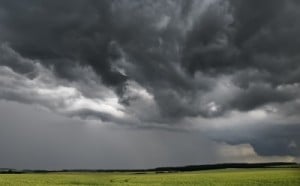As this blog posts, the East coast of the United States may or may not be hit by “Frankenstorm,” an unprecedented melding of Hurricane Sandy and another weather system barrelling across part of the country. I’m far away from the storm, but will certainly be watching and praying for all those affected, especially for people with health conditions that are difficult to manage in the best of times. Weather or not, these physical challenges make life difficult. On a day when a big storm hits, they make it, well, not exactly a “good day.”

I’ve been through a hurricane, multiple tornadoes, hail and snow storms, ice storms, and “the big” Northridge earthquake. To those afraid that their health may suffer greatly with the monster storm looming, I can say that yes, there is much out of your control. God’s natural world is awesome – and humbling – at times like these. But there are some things that I’ve done in the past (and still do) to protect myself as much as possible, especially in the aftermath of the storm, when emergency services may be stretched to breaking and power, telephones, and other utilities are out. These steps help me be more at ease when weather or other natural phenomenon loom, and that peace of mind helps me think clearly and act appropriately when something does occur. Here are some of the things I do:
1) Have a plan to communicate with loved ones. This is especially important if your circle is scattered, perhaps even out of state. Also, have a plan for evacuation, especially if the local authorities have identified the potential for evacuation.
2) Have an updated First Aid kit, emergency food and water, and an extra supply of essential medications. I include a pair of stout shoes and gloves (during the Northridge earthquake, there was a lot of shattered glass inside and out). I keep a kit at home and have one in the care in case of emergencies that occur when I’m on the road (unlike hurricanes, we don’t get warnings for earthquakes!). Into the kit(s), I also tuck a list of doctor’s telephone numbers, prescriptions, and health conditions, and a copy of my health insurance card(s).
3) Have a radio or other equipment that does not rely on electricity, and monitor emergency evacuation and other bulletins, advisories, and orders.
4) Understand that local emergency personnel want everyone to be safe, but if you decide to stay put instead of evacuate as ordered, these brave men and women may not be able to reach you for days. If you have a health condition, it’s better to leave as directed (to an established shelter, for example) than risk being out of the range of assistance if your health is adversely affected by the storm.
5) Remember your pets! Keep some emergency supplies in your First Aid kit for Fido or Fifi, too, and pack extra blankets, toys, and leashes and collars in case you have to evacuate with your furry friend.
This list doesn’t cover everything. Your local Red Cross office or law enforcement can give you guidance on specific things that might pertain to your area, and your doctors can provide you with further steps to take to make sure that your health conditions remain as stable as possible. But, these steps do give me peace of mind, and that’s so very valuable when nature wrecks havoc.
Praying for all of you in the storm’s path!
And blessings for the day,
Maureen

